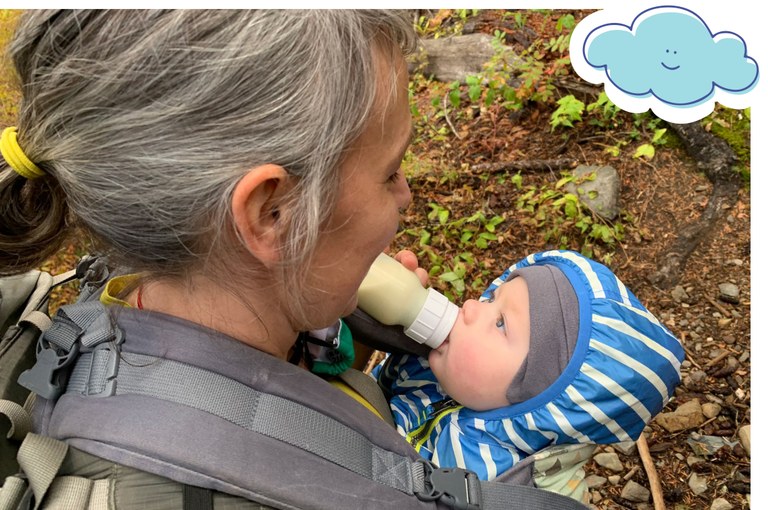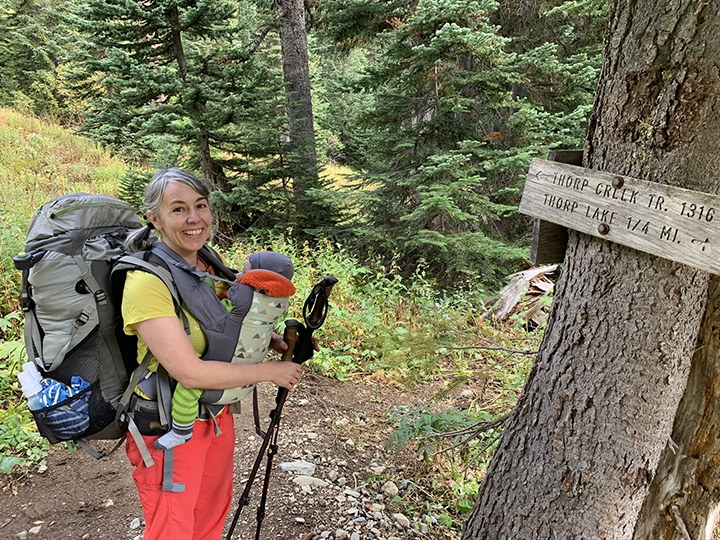 Washington Trails
Association
Washington Trails
Association
Trails for everyone, forever
It takes planning and some extra weight, but it’s worth the effort to share the joy of the outdoors with your little one. | By Loren Drummond.
A raindrop splattered on the nose of my 5-month-old, strapped into a carrier on my front, and he looked up at me with solemn eyes. I snapped a bright pink umbrella open over our heads and eyed the charcoal clouds rolling over the ridge above the Thorp Lake Trail.
When I proposed this trip to our friends — the parents of a barely walking 14-month-old — I told them to expect a little Pacific Northwest mist. A downpour was not supposed to be in the cards, and sounded like a lot less fun with two babies on their first backpacking adventure in tow.
“We’ll just start hiking and see how things go,” I told our friends as we locked our cars and made final adjustments on our heavy loads.
I was fully prepared to pull the ripcord on the trip if we all ended up soaking wet, but I was hoping we wouldn’t have to.
“We’ll reassess in a half-mile,” I said, and we started hiking.
I’d been dreaming about this trip since before my son was even born. In the first few sleepless weeks of his life, I’d searched out trip reports and articles about camping and backpacking with babies. Is there any greater joy as a parent than sharing the things you love with your children?
The idea of taking my son into the backcountry, and my determination to still take wilderness adventures, had been fixed in my mind all summer.
“We’re doing it, baby,” I whispered down to him. And as if he had been my co-conspirator on this trip, he looked back and grinned.
 Front Row seat. A front carrier for younger babies makes meals and monitoring their temperature a little easier. Photo by Loren Drummond.
Front Row seat. A front carrier for younger babies makes meals and monitoring their temperature a little easier. Photo by Loren Drummond.Taking a backpacking trip with a baby or young toddler requires a good dose of creativity and planning. You’ve just come off of a crash course in how to keep a tiny infant alive, you’re still dialing in how to get them to sleep, and now you have to learn how to do it in the woods.
We’d already tested the waters with a few car camping trips with our son. These practice runs were about a 40:60 ratio of effort to fun, but they helped us dial in our sleeping setup. We’d already done middle-of-the-night diaper changes and feedings, and we knew that an extra phone charger to keep the white noise app on our phone running was worth the weight.
But anyone who has helped raise a baby knows that there is a reason parents refer to their children in months and weeks.
A 4-month-old has very different needs from a 10-month-old, so besides deciding when your little one’s first overnight will be, you will likely need to tweak your system for each trip. Our trip to Thorp Lake was the first time I had worn our front carrier with a fully loaded pack (it was tolerably comfortable), and the pink umbrella was our solution for staying dry (it worked perfectly). I hoped the friend who was hauling a bit of extra weight for all of us wouldn’t be kept up all night by baby shenanigans. (He wasn’t.)
But we were determined to start as we meant to go. I have big dreams of backpacking with my son throughout his life, so we were determined to make hiking and camping a part of his normal from the early days.
“You were right. We should have chosen the other trail,” I said to my wife as we slogged straight up the steep mile-long section of trail before reaching the lake. I estimated both of our packs came in between 40 and 45 pounds. We’d have water at the lake, which helped lighten our loads, but we were carrying more than we were used to. I had been sure to pick a short hike — just 2.5 miles — but this had a steep section my friend called a grind. Go short and easy — that is the standard advice for choosing trails for beginning backpacking with a baby. I had gotten the short part right, but underestimated how easy 1,000 feet of elevation gain sounded. Lesson learned: Next time, choose the short, flat trail, even if it means 20 more minutes of drive time with a fussy kiddo.

1,000 feet elevation gain with baby and 45 pound pack. Photo by Loren Drummond.
Our friends, who had gone ahead when we needed to stop and fix a bottle, greeted us in a wide, flat camp. Their son grinned and staggered around, tumbling into huckleberry bushes and climbing back out again.
We relaxed into the routines of late afternoon and evening familiar to any family — changing into cozy, warm clothes, fixing dinner, tucking babies into bed. Our son was at an easy-sleep stage, and he went down at 6:30, bundled in a down suit and sleep sack in a travel bassinet in the tent. I had learned from our camping trips that I worried about him staying warm, so I put him by our heads, so we could periodically check on him throughout the night. When our friends’ toddler was asleep, the five of us gathered around our cookstove and drank hot drinks, pretty freaking proud of ourselves. We had gone to a lot of trouble packing and driving and hauling our families up here, but it was beautiful, and it had worked.
Before the sun set, I had gone down to filter water at the small lake, and the sun finally broke through the low-hanging clouds, reflecting against the cliffs on the far side. “Yes,” I thought. “This is it.” Since we had become parents in spring, so much of our lives and identities had been upended, and I had been missing the feeling of being in true wilderness. I wanted my son to experience this trip, to look up and see nothing but trees and sky. But in truth, this trip was really what I had needed to feel like myself, to envision the kind of family I wanted us to be in the years to come.

If you love backpacking, it’s definitely an activity you can share with your young child. Like most things about being a parent, what works best will depend a lot on your particular family and baby. We hope these tips and ideas help get your backpacking trips off to a good start. Things will go sideways from time to time. But if you’re prepared and strive for fun, not perfection, you’ll be able to roll with it during those early years of adventures.
Start with a practice run trip. Choose something with an easy exit, where you won’t feel put on the spot if your baby cries all night. (Dispersed camps are one option for this.)
Get your kid used to being in a carrier with lots of walks.

Naps on the go are inevitable; embrace them. Photo by Loren Drummond.
